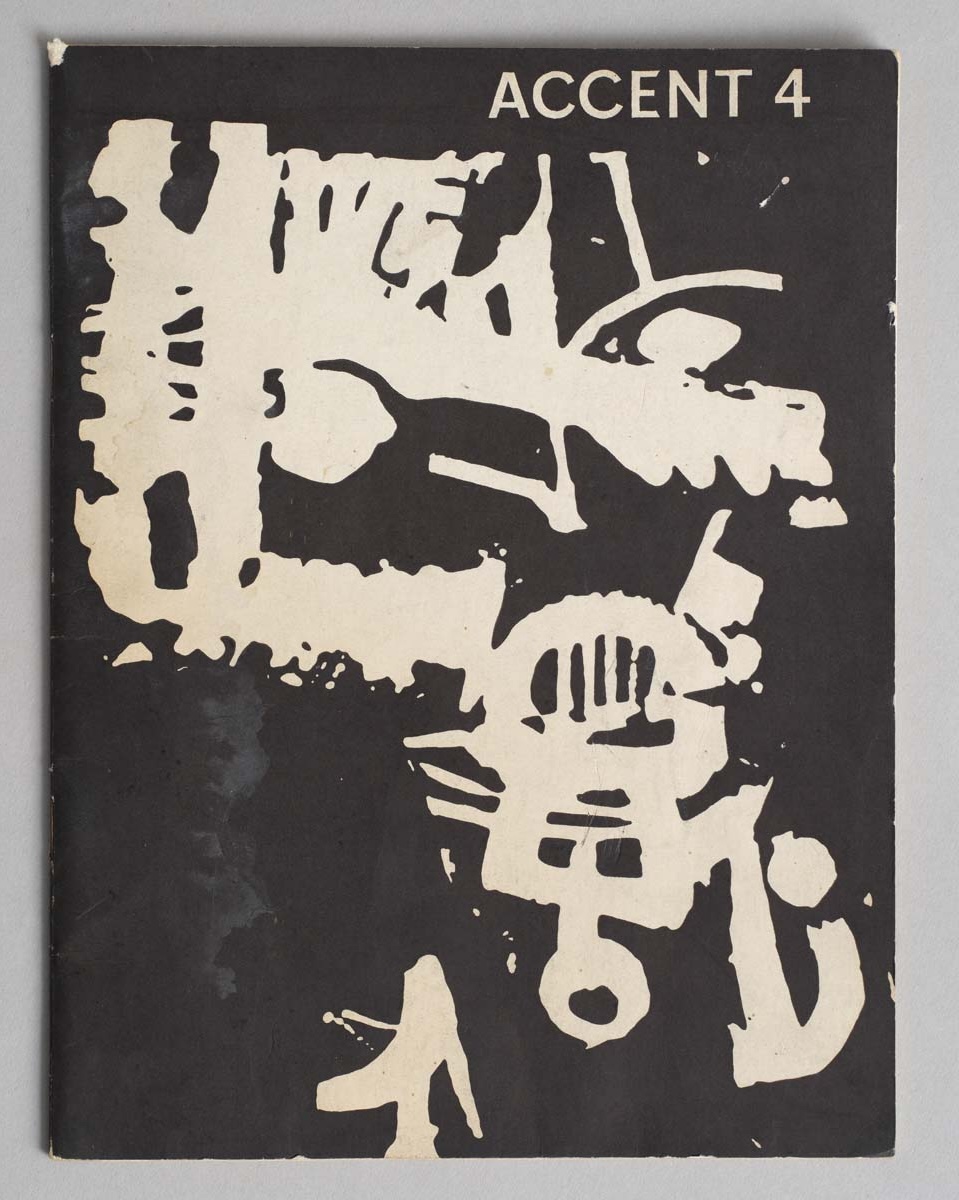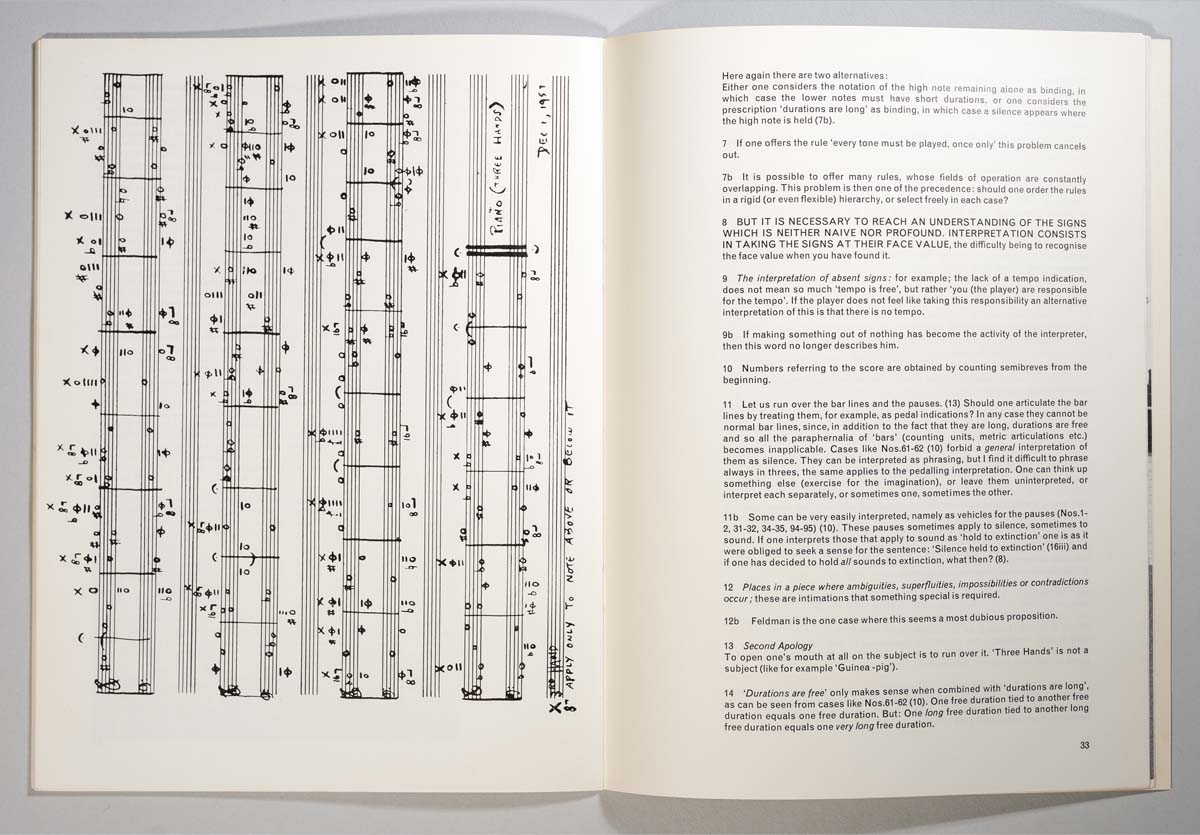 Image: Accent 4, 1962
Image: Accent 4, 1962
A piece by Barbara Hepworth opens for Accent issue four, and describes the two things that interested her the most: “…the significance of human action, gesture, and movement, in the particular circumstances of our contemporary life, and the relation of these human actions to forms which are eternal in their significance.”. (Accent 4, p.7) Then four plates (plus the cover artwork) showing work by Harry Thubron are accompanied by the following short quote by the artist and teacher: “It is only in a situation where staff and students, some expressing themselves through figurative, others through abstract forms, and both finding their way by personal choice and involvement, that a positive attitude to each can be arrived at.”. (Accent 4, p.8)
Following this we read 'Pictures of the Gone World', a poem reprinted by courtesy of the American publisher and poet, Lawrence Ferlinghetti. 'Dimensional Coordination' extols the virtues of modular buildings, particularly well expressed (we are told by G.F. Denison and J. Dain) in Japanese architecture. An article by Nicky, cartoonist for the New Statesman, shares his thoughts about his artform and his approach to his work. Next, a black and white drawing by David Gluck and a poem by Eva van Hoboken, named 'schwartz weiss', are presented side by side. Writing by Hans Hartung addresses the relationship between an artwork’s interior ‘reality’ and the reality of the physical world. Lastly, composer Cornelius Cardew studies the musical manuscript of a piece called 'Piano (Three Hands)' by Morton Feldman where the use of invented notation means the interpretation of the piece takes priority in the process of performing it so that creator, conductor and performer must participate fully and create a new piece together with each new rendition.
 Image: Article by Cornelius Cardew
Image: Article by Cornelius Cardew
Second year BA (Hons) Creative Writing student Kelsey Hearne has chosen to respond to 'Dimensional Coordination', while Lois Pullen was inspired by Barbara Hepworth’s piece. Both students have composed flash fiction.
Kelsey Hearne
Second year BA (Hons) Creative Writing
Response to Dimensional Coordination
 Image: Article by G.F. Denison and J. Dain
Image: Article by G.F. Denison and J. Dain
The persistent chime of the grandfather clock rings in Penny’s right ear. While in her left ear, the buzzing of a cicada keeps her company. A veil of warmth blankets her skin as she sits at the kitchen table. The clicking of her shoe’s sole becomes incessant. Surely, he should be home by now. With a quick glance at the clock, the brass hands indicate the exact time. Quarter past five.
Penny reasons he could be lost or he might be stuck in traffic, but there’s a small nagging fear in her. Maybe… No, I mustn't think like that, he will be okay. Twiddling the silver band around her fourth finger, she shifts in her seat. She shifts again, and then shifts for the final time. Huffing, she stands by the window with her arms wrapped around her torso. The fabric of her blue frock wrinkles and twists in her grip.
A breeze rustles the rich leaves. The gravel of the driveway remains untouched.
Fifteen minutes pass by and the balls of Penny’s feet ache, but she remains insistent on watching the road exit. Bathed in the burning orange of the dying sun, the road exit feels just as Penny does - alone. He must be lost, there isn’t any other explanation.
Penny contemplates ringing him but she cuts herself short. Him being lost is one thing, but him getting into an accident? I wouldn’t be able to cope. Instead, she squeezes past the cardboard boxes taking up a third of the kitchen and she pops out the other end. This causes her to catch her hip on the hallway’s side table; she takes in a sharp breath. She slides open the front door, ignoring the pain.
A rush of cool air greets her, threading its way through her loose stray hair. Looking past the grassy fields, Penny squints as she scratches the strands away from her face.
Her eyes widen.
A growing dot in the distance morphs into the smooth edges of her husband’s outdated car. Parking on the gravel metres away from a shaken Penny, Lucas manoeuvres himself out of the car with attentive care. The flowers he carries are delicate.
Turning around, his eyes land on Penny standing in the doorway. A sheepish smile grows on his face, but he’s unable to utter a single word as Penny crashes into him. Gripping onto his crisp white shirt, Penny buries herself into the crook of his neck. Lucas envelops her warmth with a grin as they crush the flowers between them.
Rationale
“I wrote this story inspired by the Japanese house featured in Accent 4’s essay titled ‘Dimensional Coordination’ by G. F. Denison and J. Dain. The images of the house are beautiful and I wanted to explore the possibilities within it. Writing this story is the result of this exploration, I wanted to write about a common reality in a simplistic setting. In this case, it’s Penny’s anxieties around homeownership and living in a new city and we see these anxieties through her worry for her tardy husband.” – Kelsey Hearne
Lois Pullen
Third year BA (Hons) Creative Writing
Homeward Bound
 Image: Left: Acknowledgements. Right: Article by Barbara Hepworth.
Image: Left: Acknowledgements. Right: Article by Barbara Hepworth.
There are moments where I can remember it all.
The morning sun bouncing between bricks, honey dripping from bin lids and windowsills. That time she recognised the elderflower tree, and we waited for it to blossom before turning it into wine. The steady flow of traffic that sounded like waves rolling up and down the beach – like the ones we used to run from as the foam licked our ankles clean.
In those terraced houses built too close together where there could be no secrets, and stranger’s stories became your own. Or in that alleyway we shared as a back garden, overlooking drug deals and first birthdays, barbeques and breakups. Or in that bed where four of us would pile in like kids again, and over beers or brews we would talk until the sun lent itself to the moon.
I remember those rolling hills, that dipped and soared with the swallows. How they felt too far out of reach, as if they were not for us to climb. And with the first sun of spring, how we would sit out drinking all day, until those hills watched us stagger on home. That first sun of spring which brought a longing for every summer before and every summer that was yet to come.
And he’ll often remind me that it wasn’t always this way. In fact, I don’t think I really remember it all. But I have collected the pieces like passport stamps or postcards; I keep them here so that I don’t forget. When it’s time to dream, I sort through them, reminiscing. Of waves that would sometimes beep, as they rolled up and down the length of the beach.
Rationale
“Taken from Accent 4, I immediately connected to Barbara Hepworth’s dissection of her sculptures. Hepworth explored that they were directly inspired by her surroundings and where she travelled over the years. But in particular, I was most connected to the way she felt about her home after she left. Here she says, ‘The whole of this Yorkshire background means more to me as the years have passed’. When I first moved to Leeds, all I wrote about was my love for my home, though I had never written about it before. And I’m sure when I leave Leeds, it will all come back to my life here. ‘Homeward Bound’ explores how we cannot recognise the greatness of something until its absence.” – Lois Pullen